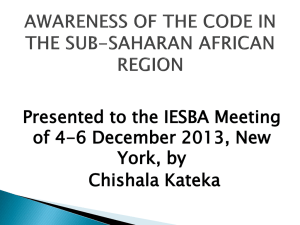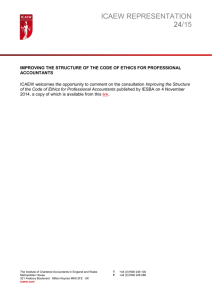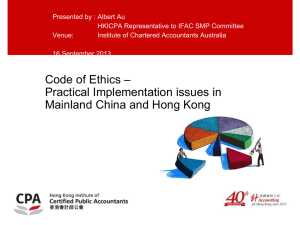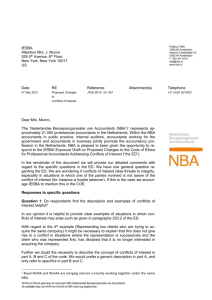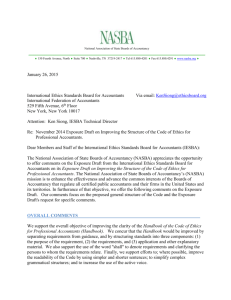Improving the Structure of the Code of Ethics for Professional
advertisement
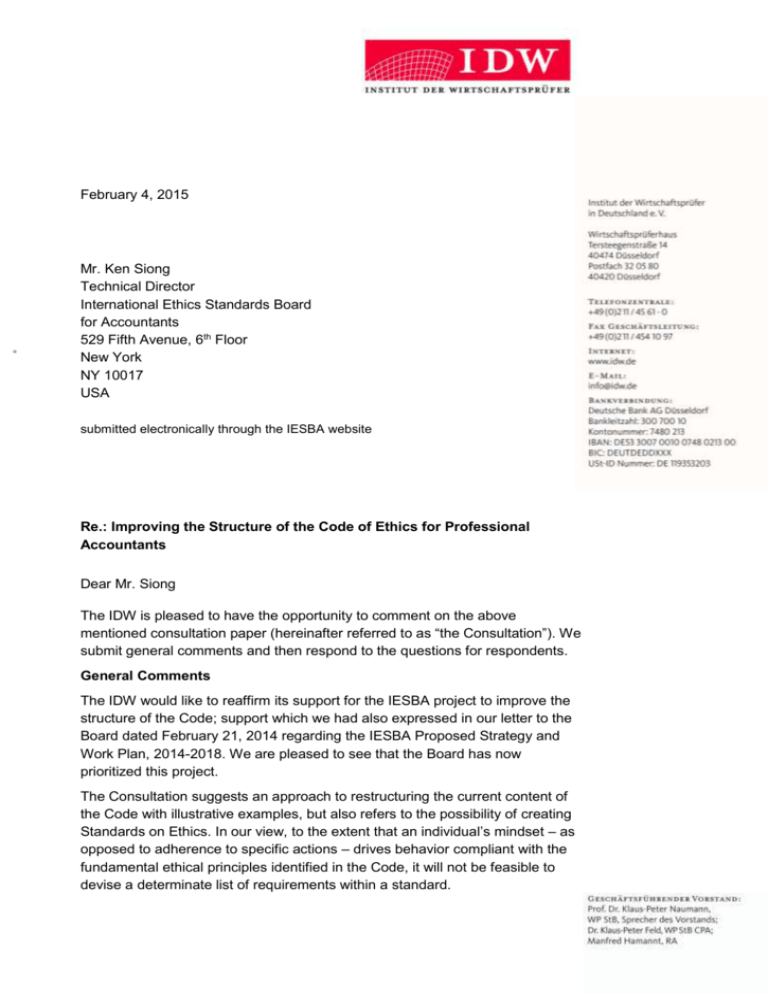
February 4, 2015 Mr. Ken Siong Technical Director International Ethics Standards Board for Accountants 529 Fifth Avenue, 6th Floor New York NY 10017 USA submitted electronically through the IESBA website Re.: Improving the Structure of the Code of Ethics for Professional Accountants Dear Mr. Siong The IDW is pleased to have the opportunity to comment on the above mentioned consultation paper (hereinafter referred to as “the Consultation”). We submit general comments and then respond to the questions for respondents. General Comments The IDW would like to reaffirm its support for the IESBA project to improve the structure of the Code; support which we had also expressed in our letter to the Board dated February 21, 2014 regarding the IESBA Proposed Strategy and Work Plan, 2014-2018. We are pleased to see that the Board has now prioritized this project. The Consultation suggests an approach to restructuring the current content of the Code with illustrative examples, but also refers to the possibility of creating Standards on Ethics. In our view, to the extent that an individual’s mindset – as opposed to adherence to specific actions – drives behavior compliant with the fundamental ethical principles identified in the Code, it will not be feasible to devise a determinate list of requirements within a standard. page 2/6 to the comment letter to the IESBA dated February 4, 2015 However, we do anticipate that it may be possible to devise a set of principles based requirements to safeguard auditor independence as we discuss in more detail in our responses to IESBA’s specific questions for respondents. Whilst we believe a restructured Code supplemented by one or possibly a few particular standards e.g., aimed at safeguarding auditor independence may be an appropriate solution, we do not believe the entire Code could be replaced with a set of Standards on Ethics. However, before the IESBA can make a final decision as to the most appropriate manner in which to restructure the Code, IESBA also needs to be clear as to whether it intends a restructured Code to go further than the extant Code, and if so for which topics. In particular, does the Board generally expect the Code to stipulate in more detail the required actions and procedures necessary to achieve compliance (the discussion on responsibilities in para 26 et seq. indicates further specification may be added), or would this issue only be addressed on case by case basis as topics are revisited or new topics emerge? Creating a more comprehensive set of separate standards covering a number of ethical topics would likely be a much more onerous task than a relatively simple restructuring along the lines foreseen in the illustrative examples. In addition, care would need to be taken that the development of standards does not mean a move away from a principles-based to a more rules-based Code. The IDW continues to believe that for the Code of Ethics to be suitable for application worldwide, it needs to remain principlesbased. As stated in our aforementioned letter of February 21, 2014, the IDW supports restructuring of the Code – which should also be used as an opportunity to clarify application issues. We had also suggested it would be appropriate for the IESBA to promulgate separate standards on practitioner independence setting forth requirements and guidance on independence. Such standards might either form an integral part of the Code, or part of a suite of ethical standards supplementing the five fundamental principles covered by the Code. Questions for Respondents 1. Do you believe that the approach outlined in this Consultation Paper, as reflected in the Illustrative Examples, would be likely to achieve IESBA’s objective of making the Code more understandable? If not, why not and what other approaches might be taken? The Consultation sets forth a possible approach to drafting components for the Code including sections denoting Purpose, Requirements and Application and Other Explanatory Material. In principle we agree that this outlined approach to page 3/6 to the comment letter to the IESBA dated February 4, 2015 restructuring would be likely to achieve IESBA’s objective of making the Code more understandable. The Consultation also states in paragraph 15 “IESBA is considering avoiding the use of present tense in “Application and Other Explanatory Material”…”. We note that in its clarity project the IAASB had decided not to use the present tense at all when referring to an auditor’s actions. We would also support the IESBA adopting this stance, as we believe that the use of present tense is a particularly important issue in achieving clarity of meaning. However, the Illustrative Examples indicate the difficulties in achieving this if material from the extant Code is merely “reshuffled”. In particular, we note instances of repetition and, in certain instances, believe that further guidance would be beneficial to assist practical application. This will be particularly necessary in regard to the issue of independence and thus we believe a set of standards on independence should be considered in place of Parts IV and V. 2. Do you believe that the approach outlined in this Consultation Paper, as reflected in the Illustrative Examples would be likely to make the Code more capable of being adopted into laws and regulations, effectively implemented and consistently applied? If not, why not and what other approaches might be taken? Such an improved structure may be helpful in comparison with the current structure, in that readers will be better able to understand what is required of professional accountants and to differentiate those situations in which specified actions are always required from those where professional accountants may be required to choose an appropriate action from a possible range of actions. This should, in turn, help resolve implementation issues and improve consistency in this regard. Whilst this may also affect take up of the Code, there are many other factors that will impact adoption into law and regulation, including the achievement of a stable platform for a reasonable period of time together with a commitment to cost: benefit considerations on the part of the IESBA. As noted above, we believe that rather than Parts IV and V, a set of standards on independence should also be considered. page 4/6 to the comment letter to the IESBA dated February 4, 2015 3. Do you have any comments on the suggestions as to the numbering and ordering of the content of the Code (including reversing the order of extant Part B and Part C), as set out in paragraph 20 of the Consultation Paper? We do not hold particularly strong views as to the suggested approach to numbering. We would, however, have expected to see either discussion in the Consultation or illustration to indicate how IESBA is proposing to more clearly differentiate the provisions applicable to public interest entities from those applicable to other entities, especially in respect to auditor independence. We believe that many professional accountants in private practice throughout the world would find a clear overview of these differences helpful. 4. Do you believe that issuing the provisions in the Code as separate standards or rebranding the Code, for example as International Standards on Ethics, would achieve benefits such as improving the visibility or enforceability of the Code? In our view, issuing the provisions in the Code as separate standards and rebranding the Code, for example as International Standards on Ethics are two very different restructuring possibilities. As we have discussed in our general comments above, developing the provisions in the Code to constitute a series of truly separate standards would not be feasible for all topics, and developing useful standards would likely necessitate the addition of further material to provide clarification in some areas, and would thus be far more onerous than the approach suggested in the illustrative examples. We do not see that rebranding the Code, for example as International Standards on Ethics – without developing a full set of such standards – could have a significant impact on improving its visibility. However, we would expect that clarifying ethical requirements and providing guidance material thereto for topics such as auditor independence would improve both professional accountants’ understanding of the actions and non-actions ethical behavior in accordance with the Code demands on their part, and that of those responsible for enforceability. We refer to our general comments above concerning the desire for separate standards in regard to independence. page 5/6 to the comment letter to the IESBA dated February 4, 2015 5. Do you believe that the suggestions as to use of language, as reflected in the Illustrative Examples, are helpful? If not, why not? Paragraph 23 lists measures to enhance the readability and clarity of the Code. We agree with the content of this list. We further believe that a robust definition of each key term used in the Code is essential to proper application by professional accountants. To the extent that the understanding of a particular term or terms is key to the application of requirements of a particular standard, it would be useful to include the definition(s) – certainly in the paper based version. 6. Do you consider it is necessary to clarify responsibility in the Code? If so, do you consider that the illustrative approach to responsibility is an appropriate means to enhance the usability and enforceability of the Code? If not, what other approach would you recommend? We agree with IESBA that a global Code should be sufficiently flexible to accommodate different circumstances that firms need to take into account when prescribing responsibilities (para. 27 of the Consultation). However, professional accountants need clarity as to what is expected of them individually, and how such responsibilities tie in with their respective firms’ or employers’ responsibilities. To the extent that it makes sense for certain responsibilities to be assigned, the Code should be clear. 7. Do you find the examples of responsible individuals illustrated in paragraph 33 useful? We believe that the examples alone are not very useful. Guidance would be needed to explain factors that may influence decisions on firm’s responsibilities. Guidance would also need to address how e.g., a sole practitioner might be expected to comply. 8. Do you have any comments on the suggestions for an electronic version of the Code, including which aspects might be particularly helpful in practice? We have no further comments to add to the discussion in the Consultation. page 6/6 to the comment letter to the IESBA dated February 4, 2015 9. Do you have any comments on the indicative timeline described in Section VIII of this Paper? Drawing on the experiences of the IAASB in relation to the clarity project, the timeline appears ambitious, given the need to adhere to due process. As we also explain above, we believe that development of a set of standards on ethics would be more onerous than a restructuring of the current Code along the lines depicted in the illustrative examples. 10. Do you have any other comments on the matters set out in the Consultation Paper? As explained above, we believe that there is a need for IESBA to address certain fundamental issues before commencing restructuring of the Code. We refer to these comments. In particular, we are concerned that IESBA needs to be very sensitive to the need for the Code to be workable in all environments e.g., firm sizes etc. worldwide and thus believe that a think-small-first approach is needed. We trust that our comments will be helpful to the Board. If you have any questions relating to our comments in this letter, we should be pleased to discuss matters further with you. Yours sincerely Klaus-Peter Feld Executive Director 494/584 Helmut Klaas Director, European Affairs
